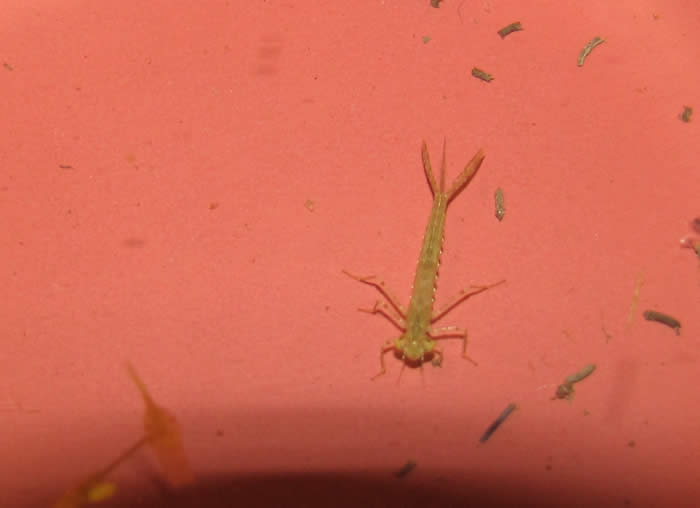Evolving to Survive: Self-Amputating Insects Sacrifice to Live by Jennifer Gleason, Douglas Fudge and Beren Robinson

Some creatures will do anything to survive, including giving up parts of their bodies. University of Guelph researchers have found such self-amputation is an evolutionary response in damselflies.
The researchers found that when predators such as dragonflies attack larval damselflies in ponds, the prey can detach propulsive leaf-life structures called lamellae from the end of its abdomen. Most interestingly, the greater the dragonfly threat, the more readily the lamellae detached.
The study, “Eco-mechanics of lamellar autotomy in larval damselflies,” was published in the January issue of the Journal of Experimental Biology. Jennifer Gleason, a 2012 graduate of Guelph’s zoology program who now works at the University’s Biodiversity Institute of Ontario, was lead author.
She gathered damselflies from ponds with more or fewer dragonflies. Dragonflies are prey for fish; fewer dragonflies are found around ponds containing more fish.
After dissecting the insects, she measured the force needed to remove their lamellae, as well as joint size and cuticle width where the structures joined the body. Specimens from ponds with more fish had larger cuticles, and it took more force to detach their lamellae than from damselflies in ponds with more dragonflies.
“This shows the group facing more attacks developed an adaptive evolutionary response,” Gleason said.
“Fish do eat both dragonflies and damselflies. But having lamellae that can detach is not a useful survival response to being eaten by a fish. In ponds without fish, dragonflies thrive and are a bigger threat to the damselflies. So having lamellae that can break apart could mean the difference for a damselfly between being dinner and living for another day.”
Gleason’s thesis co-supervisor, Prof. Beren Robinson, Integrative Biology, said researchers often study how prey evolve and develop clever strategies to thwart predators.
“This shows how organisms can evolve to make the best of a bad situation by sacrificing a piece of themselves to get away,” he said.
“Even humans have evolved a variety of ‘good-enough’ rather than ‘perfect’ features – like the imperfect design of our lower backs and knees. We often naively think natural selection creates ‘perfect’ organisms, but it’s pretty rare for various reasons. Instead, traits evolve that make organisms good enough by improving the chances of survival and passing genes on to offspring.”
Past studies showed lamellae can regenerate after being detached, which Gleason found in her specimens.
“We found cases where a damselfly had recently survived an attack, as it had two regular-sized lamellae, and one smaller one that was just growing,” she said.
“Such self-sacrifice is a reasonable adaptive solution to making the best of a bad situation. They’re doing whatever it takes to survive.”
The researchers hope to study changes in genes coding for this trait.